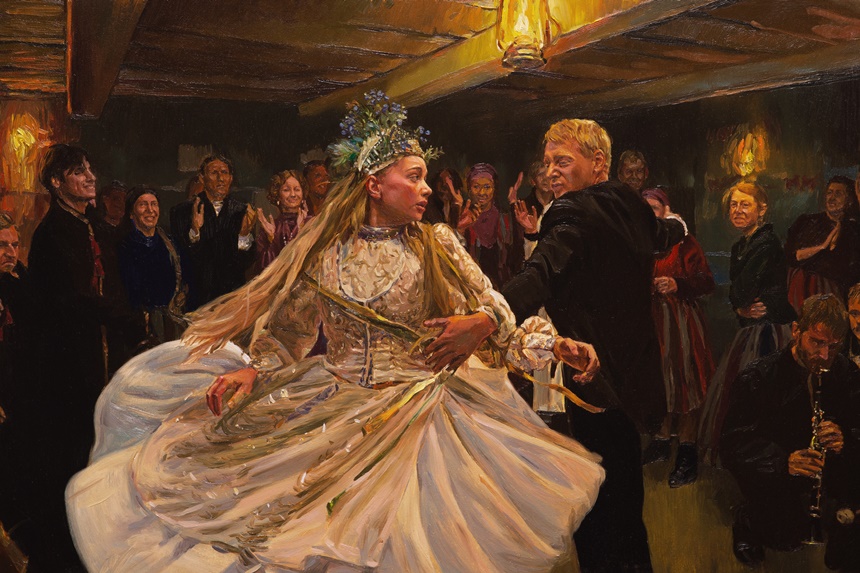The Peasants
⭐️ ⭐️ ⭐️ ⭐️
Rating: R
Run Time: 1 hour 54 minutes
Stars: Kamila Urzedowska, Robert Gulaczyk, Miroslaw Baka
Writer/Directors: DK Welchman, Hugh Welchman, Wladyslaw Stanislaw Reymont (novel)
Reviewed at the Toronto International Film Festival
One of the great paradoxes of film is its ability to embed ugly reality within scenes of unexpected beauty. The strikingly artful images of movies like Goodfellas, Schindler’s List, and Pan’s Labyrinth do nothing to minimize the awful events unfolding onscreen — and in fact often serve to magnify them.
You’d be hard-pressed to name a film more visually striking than The Peasants, a lavish movie animated entirely with oil paintings created over five years by a team of 100 Eastern European artists. Directors DK and Hugh Welchman used the same technique for their jaw-dropping 2017 film Loving Vincent, but while that movie was something of a sentimental — if ultimately tragic — look at the last days of Vincent Van Gogh, The Peasants tells a gritty tale of crushing poverty, cruel exploitation, unleashed lust, and abject hatred.
Yet, somehow, the final product is achingly alluring.
At the film’s center is Jagna, a striking young woman whose delicately artistic sensibilities make her an outlier in her hardscrabble, turn-of-the-20th-century Polish village. Jagna is “played” by Polish actress Kamila Urzedowska — fair to say because the directors first shot the entire film in live action, then had their team of painters re-create the result, frame by frame.
In this rough-and-tumble world of farmers and woodsmen, a woman like Jagna has one practical purpose: to marry well. And, as if on cue, she catches the eye of Maciej, the town’s richest man (Miroslaw Baka), whose wife has just died.
One catch: Besides being lovely and talented, Jagna is also fiercely independent; a prototype 20th century woman chafing against a culture firmly set in the Middle Ages. Oh, one other catch: She is also hopelessly smitten with Maciej’s hot-tempered son Antek (Robert Gulaczyk), who is already married.
Reluctantly, at the incessant urging of her mother, Jagna marries the old man, but that does not mean she’s about to give up her infatuation with her newly acquired stepson.
All of this hot-blooded passion adds up to the steamiest cartoon since The Nine Lives of Fritz the Cat, only Ralph Bakshi’s landmark 1972 ’toon-for-grownups didn’t frame its sexy action in settings inspired by the old masters of Poland’s Late Romantic Period.
The rap against animated films that approximate real people in actual settings is that they toil unnecessarily when a simple live-action approach would have sufficed. Indeed, the intensive labor that was poured into The Peasants is emphatically visible onscreen (one animation team, in besieged Ukraine, had to sit by their computers for hours on end waiting for the electricity to be restored so they could continue their work).
But the Welchmans aren’t mere technological exhibitionists: In the tradition of filmmakers from Hitchcock to Goddard, even as they draw us into their tale of human passions, with every frame they remind us we are watching a movie. As the film’s most breathtaking scene unfolds — at a marriage feast in which the “camera” spins, dips, and whirls with the increasingly frenetic, gloriously dressed dancers — we’re not flies on a wall at a Polish wedding; we’re flies on the wall of a museum bedecked with hundreds of masterful paintings of that Polish wedding.
Invested as we are in the characters, each self-conscious moment fosters a subtle state of audience detachment, reminding us to relate the film’s themes of individuality and intolerance to the real world that exists outside its exquisitely crafted frame.
Become a Saturday Evening Post member and enjoy unlimited access. Subscribe now



